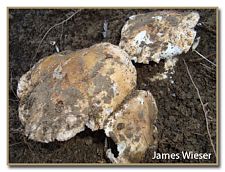Tricholoma populinum
Sand Mushroom, Poplar Tricholoma
Order Agaricales, family Tricholomataceae
 CAP LARGE, PINKISH BROWN, WHITISH WAVY MARGIN
CAP LARGE, PINKISH BROWN, WHITISH WAVY MARGIN
Cap: 3-16 cm broad, conical, some with low knob, margin whitish, inrolled when young, then upturned and irregular when mature. Colors often radially streaked, off-white to cinnamon brown, surface sticky when moist.
GILLS WHITE, STAIN REDDISH-BROWN
Gills: close, even edges, notched at stalk.
STALK STOCKY, WHITE STAINING RUSTY BROWN
Stalk: 2.5-7.5 cm long x 1.5-3 cm wide, smooth, no ring, sometimes enlarged at base, solid, tough
 SPORE PRINT WHITE
SPORE PRINT WHITE
Spores 5-6 x 3.5-4 µm, elliptical, smooth, non-amyloid
IN SANDY SOIL NEAR POPLARS, IN LARGE CLUSTERS OR RINGS
EDIBLE
Lookalikes:
Tricholoma pessundatum (poisonous) – grows under conifers
YOU MIGHT ALSO LIKE TO KNOW....
Mushroom hunters of all kinds, including the urban variety, get really depressed when the loves of their lives (mushrooms) start to disappear for the season. Rather than running for antidepressant drugs, urban mushroom hunters will search for T. populinum, which is widespread in North America in the fall.
James Wieser tells us that one year he found Sand Mushrooms in Colorado until Nov. 31, the last day before “the first big snow storm hit,” staving off the end-of-mushroom-hunting blues to the last possible day. In Colorado, it grows in dense clusters under cottonwoods in sandy creek beds. T. populinum should only be eaten if found growing in large clusters under poplars. There are similar Tricholomas under conifers that cause gastric problems.
The problem with the Sand Mushroom, when it comes to eating, is the sand. It’s covered with it. How to deal with this? We recommend taking a hint from the deer and the Native Americans. Vera Evenson, author of Mushrooms of Colorado, writes that Native Americans reportedly loved the Sand Mushroom, and they presumably consumed a fair amount of sand with it, because it’s impossible to get it all off. Neither, Evenson reports, does the sand stop deer that routinely feed on T. populinum, traipsing through river-bed duff in search of mushrooms.
Squirrels also go for the Sand Mushroom, and James Wieser uses this to his advantage in finding the mushroom, which is usually partially buried or pushing through the soil to make a “shrump” or little mound in the ground.
“More often than not, I will find a piece of a mushroom dropped by some critter on the leaves,” Weiser tells us. “Then I’ll start looking for mushrooms in the area.”

